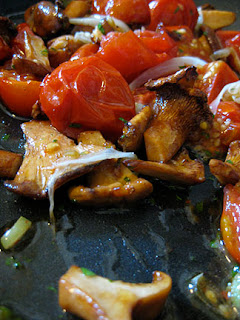Summer offers up a huge bounty of beautiful, fresh produce. Fruits and vegetables taste best when picked at the height of their
natural season...it's a simple fact. Given today's society's ability to ship anything from anywhere, we don't necessarily cry when summer is over. But imagine if we didn't have the option to simply go buy a mealy tomato or rock-hard/sour peach in the middle of winter. For those of us living in the practically-non-seasonal climate of California I know we would take seasonality a lot more seriously if we were living in, say, Vermont. In Vermont, winter - and I mean REAL winter - likes to stick around for a good 6-7 months of the year. Spring is muddy and fall is brisk, so summer actually
means something. And the plants are there to prove it. They push up out of the ground at amazing rates; the combination of intense sun and quick-but-plentiful rain showers make for the perfect setting for speedy growth. Now imagine you're a farmer 100 years ago. You rely on the land for
everything. You have to grow enough food to get you through the next winter; if you make a bad crop, you suffer. If you waste anything or fail to store enough of your crop, you're screwed! This idea has fascinated me ever since my first reading of
Little House in the Big Woods and the rest of Laura Ingalls Wilder's books. I've always loved reading about living off the land and bringing in the harvest. In
Animal Vegetable Miracle, Barbara Kingsolver makes it clear that, come July, the vegetable garden becomes a full-time job; picking loads of food every day and then canning, preserving, stewing, drying, freezing, pureeing, storing and otherwise readying these perishable items for the long year ahead. A lot of work, yes. But the idea that you can provide for yourself...that you don't have to resort to tasteless, out of season produce shipped from 1000's of miles away (wasting precious fossil fuels), picked by laborers slaving away for next to nothing (instead of raising their own food) and who work for huge, corrupt corporations that make a practice of destroying the natural world around them...yeah, avoiding all that is a really nice idea.

As someone trying to eat as seasonally as possible - even though I don't
have to - pickling is a very attractive prospect. For one thing, you can pickle almost anything...for another, the acidic nature of pickling means you can ease your mind about the one big fear that goes along with canning:
botulism. One of the most deadly - but also rare - bacterias ever, botulism can occur in food that is not canned properly (meaning the food was not processed at a high enough temperature or the acid content of the food was low). If you're canning plain green beans, you should be concerned (and probably use a pressure canner). But if you're
pickling green beans, that's a whole different story...you're storing them in
brine, baby! Doesn't get more acidic than that.
For this pickling round I wanted quick results. I know most methods require at least a few days of fermentation...but I had a BBQ planned for the next day and needed more immediate pickles. Luckily Alice Waters came to the rescue. I used her basic recipe for "fresh-pickled vegetables" as described in
The Art of Simple Food and it worked perfectly for this situation.
 Fresh-Pickled Veggiesadapted from The Art of Simple Food
Fresh-Pickled Veggiesadapted from The Art of Simple Food1 1/2 cups vinegar (cidar, white wine, distilled white...I used half cidar, half distilled white)
1 3/4 cups water
2 1/2 TB sugar
1 bay leaf
4 thyme sprigs
pinch of dried chile flakes
1/2 tsp coriander seeds
2 garlic cloves, peeled and cut in half (use more if you like)
a big pinch of salt
(keep in mind that these herbs, etc. are just suggestions; you could add whole chilis, dill or other fresh herbs...whatever you like!)

Bring all ingredients to a boil.
Cook each type of vegetable separately in the brine, removing them when they are
just cooked (but not soft)...you want them to still have some crunch! Most vegetables shouldn't take more than a few minutes. Taste-test to see when they're done.

I reused the cooking brine for all of my vegetables, but saved the more potent types - like turnips and jalapenos - for the end, lest they over-influence the other, milder veggies. Since the brine had reduced considerably I made a fresh batch for pouring into the jars; just bring it to a boil first!
Place the veggies in mason jars - I also added some more garlic cloves and salt at this point - and pour the boiling brine over the top so that all the veggies are completely submerged. Let cool a little if you want, then seal and refrigerate. They will be ready immediately thanks to the neat trick of cooking them in the brine first.
You can pickle a wide variety of vegetables with this method. You'll want to keep them fairly small: slice large carrots and jalapenos into inch thick pieces, break cauliflower into small florets, cut turnips into wedges, chop fennel into slender pieces, halve small pearl onions...you can use whole green beans, and if you want to make pickled red onions simply slice them thin, place them in a jar and pour the boiling brine over the top.
It's amazing how many uses you can think of for pickled veggies. For my BBQ we heaped them onto grilled flank steak sandwiches with burrata cheese and arugula. My favorite pickles were the fennel and the turnips; the pickling mellowed the fennel and somehow captured the sweetness of the turnip while avoiding their more spicy, bitter notes. The guys loved the pickled jalapenos, which were mellowed out
some but still packed a spicy punch. I have since mixed pickled onions with some cilantro, ginger and soy sauce and used as a topping for an Asian soup and I used several kinds of pickles on my scrambled-egg breakfast burrito this morning. I plan on doing more pickling this summer - including the longer version requiring more intense fermentation - and hope to be enjoying my own home-made pickles all winter long.

- Happy Pickling -



















































